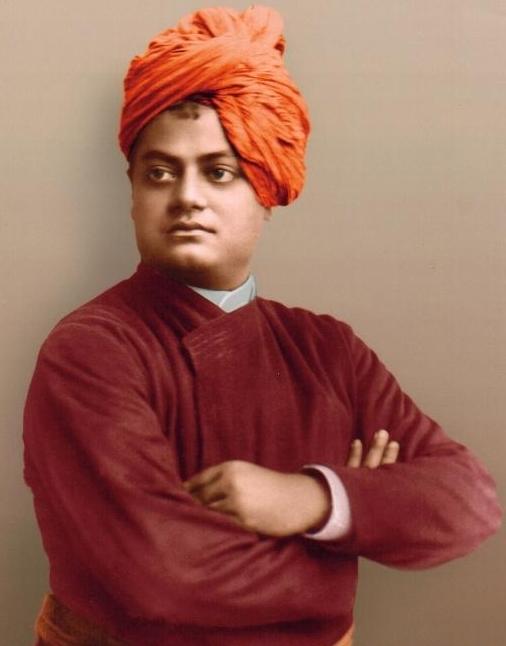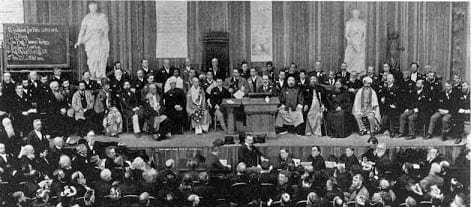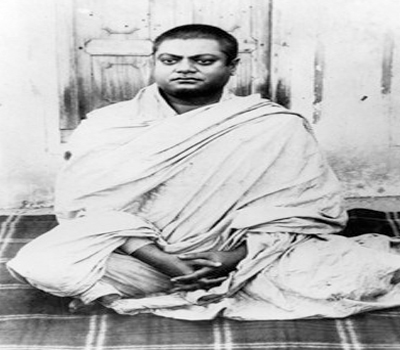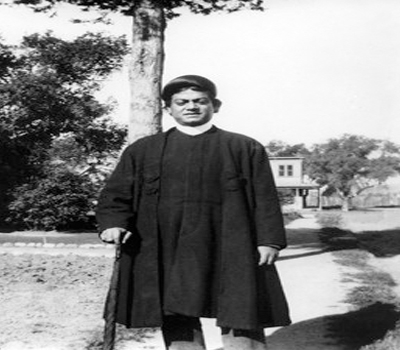In 1893, Swami Vivekananda set sail to America to participate in the World’s Parliament of Religions with just one introductory letter to a high-society couple. This article draws attention to Sri Varada Rao who gave that letter.
Introduction
Prior to Swami Vivekananda’s departure from India in 1893 to attend the Parliament of Religions in Chicago, one Mr. Varada Rao from Madras gave him a letter of introduction to a high-society couple in Chicago. This is how the Life put it:
One of his Madras friends, Varada Rao, wrote to a lady of his acquaintance in Chicago about the Swami. She and her husband belonged to the highest Chicago society, and were very kind to the Swami. Thus began a friendship that lasted as long as the Swami lived. All the members of the family came to love him dearly, to appreciate his brilliant gifts, and to admire the purity and simplicity of his character, to which they often bore loving testimony. We, however, do not definitely know their names; but in the opinion of some researchers they were Mr. and Mrs. Milward Adams.1
In the Life’s electronic version (Swami Vivekananda: Life, Works, and Research) later, this statement has been replaced by: “One of his Madras friends, Varada Rao, introduced him to a socially prominent Chicago couple, who were, as the Swami wrote on 20 August 1893, ‘so very kind to me.’” Someone eventually realized that it could not have been Mr. and Mrs. Milward Adams, whom Swamiji came to know much later. The couple to whom Varada Rao had introduced Swamiji was Mr. and Mrs. Erskine Mason Phelps. It took over one hundred years to finally solve the mystery.2 Whereas the identity of the “socially prominent Chicago couple” was established, owing to the serendipitous discovery of a letter that a Unitarian woman had written to a Chicago divine, that of Varada Rao’s wasn’t; it has been haunting some resolute researchers ever since.3 Regardless of whether Swamiji enjoyed his stay at the Phelps residence or not, Rao was singularly instrumental in arranging for Swamiji’s first accommodation in an American home. That was a big deal, which deserves Varada Rao a place in history.
Going back a little, it has been alleged that Swamiji never revealed the couple’s name in any of his letters, which was why nobody was able to determine their identity.4 But that is not entirely correct. In a letter he wrote to Prof. J. H. Wright on September 4, 1893, he seems to have mentioned a name “Theles.” He wrote, “I have received a letter from Mr. Theles of Chicago giving me the names of some of the delegates and other things about the Congress.”5 It appears that Swamiji wrote “Phelps,” but it was transcribed incorrectly as “Theles” in the Complete Works. Swamiji had been with the Phelpses less than a month ago, and apparently was corresponding with them, at least for a short period after he had left Chicago for New England. According to the Chicago Historical Society, many prominent Chicagoans failed to leave their personal papers behind—Erskine Mason Phelps being one of them. Here was a lost opportunity to find some of Swamiji’s letters.
Who was Varada Rao?
In a letter to Alasinga Perumal in August 1893, which was Swamiji’s first known letter to India after arriving in America, he actually used Varada Rao’s name twice. First, it was “The lady to whom Varada Rao introduced me and her husband belong to the highest Chicago society, and they were so very kind to me,” and second, “And the gentleman, to whom Varada Rao introduced me, is one of the directors of the Fair.”6 That was the extent of it. The only inference one can draw from the tone of the statements is that Perumal knew who Varada Rao was. It is hard to understand why Perumal, or others who were privy to the contents of Swamiji’s letter and knew Rao, did not contact Varada Rao to identify the Chicago couple and reveal how the former came to know them. Maybe it wasn’t too important to them at that time since they all knew the story. When the Life came out with its first edition in 1912-14 the trail had become too cold (Perumal died in 1909) and the unknowns too many; Varada Rao’s name wasn’t even mentioned in that edition. It was ultimately mentioned, probably for the first time, in the fifth edition, published by Advaita Ashrama in 1979. Looking through the local government papers from that era, the only reference to a Varada Rao one could find was with respect to one Tumalapalli Varada Rao, who rose to a position of Sub Judge in Madras in 1899. He was a probationer for the Civil Service in July 1885 and rose to the position of Assistant Collector and Magistrate in December 1886. He also seemed to have been the Acting Head Assistant Collector of Tirunelveli in 1890.7 The “India List and India Office List” gives us some additional information about Varada Rao’s credentials:
VARADA RAO, Tumalapalli, B.A., B.L., Statutory C.S. (sub-judge Mcuiras [Madras]). — Educ at Madras Univ. ; probr. for the civil service, July, 1885 ; asst. collr. and mag., Dec, 1886; confd. [confirmed] in civil service, 17th Aug., 1887; sub-judge, Mar., 1899.8
How did Varada Rao come to know Swamiji?
When Swamiji arrived in Madras in January 1893, he met with many prominent Indian businessmen, civil servants, and literary figures in that region and came to know some of them intimately. He was a guest at Manmatha Bhattacharya’s house, who was then the Deputy Account General of Madras, a rather high position in the Government circle. It is quite possible that Varada Rao met Swamiji there. Varada Rao was also a civil servant of high ranking, and probably knew Mr. Bhattacharya personally in that capacity. The Life gave an extensive account of Swamiji’s time at Manmatha Bhattacharya’s house on Beach Road, St. Thome, and how he interacted with the local people from all walks of life.9 Varada Rao could have been present at one or more of the “conversaziones” at the Literary Society of Triplicane that Swamiji held and became friendly with him. In one of these meetings, it was probably decided that “Swamiji should be sent to the Chicago Congress.”10
How did Varada Rao come to know Erskine Mason Phelps?
Assuming the identification of Varada Rao to be correct, and that we have established a plausible Swamiji-Varada Rao connection, the question that remains is: how did Varada Rao come to know Mr. Phelps, the CEO of Phelps, Dodge & Palmer, an enterprise that enjoyed both local and national fame as a premier shoe and boot manufacturing company in America? Mr. Phelps was no ordinary business executive. He was instrumental in electing Grover Cleveland to the presidency of the United States and was his confidant and advisor.11 How did an Assistant Collector from Madras come to know this important American from thousands of miles away?
To answer that, we have to look at the May 5, 1892, issue of the Chicago Tribune newspaper. It seems that Mr. Phelps, when he became a member of the World’s Columbian Exposition Commission, went on an eightmonth world tour with his wife in 1891-1892 in the interest of the Commission. One could call it a “World’s Fair promotion tour.” He was accompanied by, among other prominent Chicagoans, Columbus R. Cummings, a millionaire banker from Chicago who was Mr. Phelps’ neighbor on Indiana Avenue. The Chicago Tribune reported as follows:
NEW YORK, May 4,—[Special]—Among the Chicagoans who arrived in New York from Europe today on the Teutonic were Columbus R. Cummings, Erskine M. Phelps and wife, Charles L. Hutchinson, ex-Senator Farwell and wife, H. M. Kinsley, and W. S. Hutchinson. Mr. and Mrs. Phelps are at the Windsor and Mr. Cummings is at the Holland House. They will have completed a trip around the world when they reach Chicago, which will probably be the latter part of this or the first of next week…. “We have all enjoyed the best of health during our trip of nearly eight months,” said Mr. Cummings. We took our time, and a jolly good time it was, too. But we are glad to be back after so long an absence. We left Chicago Sept 17, spent a week in San Francisco, then a month in Japan, another month in China; went from Singapore to that magnificent island, Ceylon, and started from there across India for Bombay on New-Year’s day [January 1, 1892]. We journeyed on elephants in India. We were a month in India and another month in Egypt. The rest of the time was spent in Europe….
Mr. Cummings was deeply touched by the extreme poverty of India. In India he says the condition of the natives under British rule is going from bad to worse. The merchants in the Orient are in a bad way owing to the depreciation of the value of rupee paper, which is payable in silver. The latter commodity depreciated 10 percent, Mr. Cunningham says, during their short stay in Asia.
The newspaper report does not mention their route from Ceylon to Bombay, or any other details of their sojourn in India.
Swamiji had heard about the Parliament of Religions towards the end of 1891, or early 1892, while traveling through Western India. The editor of The Hindu (published from Madras), Mr. Ganapathy Dikshitar Subramania Iyer, was a member of the Advisory Council of the Parliament of Religions. In that capacity he must have received all the announcements and literature concerning the Parliament. It is quite possible that the news about the Parliament was published in his newspaper around that time.12
It is conceivable that the Phelpses had made a beeline for Madras to play the role of the “traveling ambassador” of the World’s Columbian Exposition of which the Parliament of Religion was an auxiliary part. If Erskine Mason Phelps and his team wanted to publicize and promote the World’s Fair in India, meeting a prominent newspaper editor in Madras who was already clued-in to the event would have been a necessary prerequisite. Moreover, Madras was then a prominent city in Southern India, the capital of the Madras Presidency. It is then also conceivable that the Varada RaoPhelps connection was established during some reception for the influential American guests in Madras in early1892. They could also have met in connection with shoe or leather importexport since Phelps was in shoe manufacturing business. Madras was then India’s premier leather exporter. Swamiji was an itinerant monk then, spending time at various places in Gujarat; he hadn’t yet met Varada Rao.
Conclusion
Swamiji arrived in Madras in January 1893, and when it was finalized that Swamiji would be leaving for Chicago in May 1893, Varada Rao presented him with the letter of introduction to Mr. and Mrs. Erskine Mason Phelps, whom he had presumably met a year earlier. That must have happened before midApril 1893, when Swamiji left Madras for Khetri; from there he proceeded to Bombay and finally left for America on May 31, 1893.
A few days after his arrival in Chicago, Swamiji contacted the Phelpses and they welcomed him to their home; that was how they became Swamiji’s first host in America.
One cannot yet find a conclusive documentary proof that that was what exactly happened, but the circumstantial evidence is quite strong. If it walks like a duck, quacks like a duck, looks like a duck, then it must be a duck. A look into the copies of The Hindu or other Madras newspapers from the early part of 1892 may put an end to the speculation, and the author challenges future researchers to do that.
(The author is grateful to Mr. Karthik Bhatt for providing him with the information on Varada Rao.)
References
1) The Life of Swami Vivekananda by His Eastern and Western Disciples. Advaita Ashrama, Mayavati, Sixth Edition, 1:402.
2) Swami Vivekananda in Chicago-New Findings. Asim Chaudhuri. Advaita Ashrama, Kolkata, pp. 62-63.
3) Ibid., pp. 148-150.
4) New Discoveries, 1:18.
5) The Complete Works of Swami Vivekananda, 7:449.
6) Ibid., 5:11-19.
7) Private communication with Mr. Karthik Bhatt of Chennai.
8) https://archive.org/stream/ indialistandind00offigoog/ indialistandind00offigoog_djvu.txt
9) Life of Swami Vivekananda. pp. 361-370.
10) Life of Swami Vivekananda. p. 367.
11) http://archive.org/stream/ chicagoitshisto02currgoog/ chicagoitshisto02currgoog_djvu.txt
12) Swami Vivekananda in Chicago – New Findings, pp.46-47.
Source : Vedanta Kesari, April, 2021






Leave A Comment